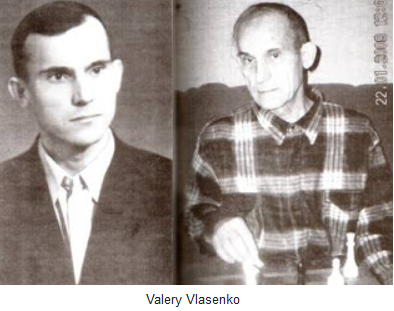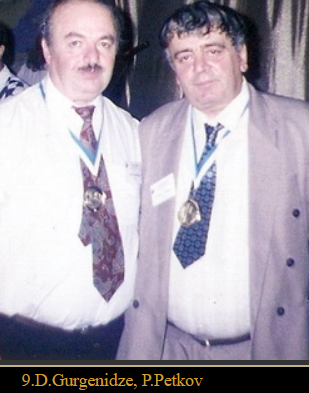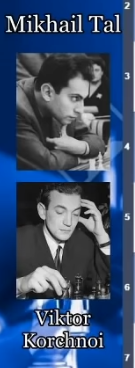Did you know what a "negative" (Knight) Rosace is? I didn't know either. I just learned it with this amusing (and not so easy) h#3. Another "crazy story" with a surprise. In the h#5.5, it's not easy to guess the square where the bK will be mate. The last helpmate has something in common with the first two, while being... the easiest of the four!

 Everything is prepared in the 2#. So what's the deal? The first 3# is a festival of batteries, the second a festival of sacrifices. We know the Plachutta theme, but its inventor prefers... the swallow. The other 5# shows... the hare and the tortoise. The 7# is a festival of returns. Finally, an astonishing selfmate that I don't think is well known. I forgot to remove the solution, but you can open the diagram, hide with your left hand what's on its right, lower it gently, and then click on "practice", just above the author's name.
Everything is prepared in the 2#. So what's the deal? The first 3# is a festival of batteries, the second a festival of sacrifices. We know the Plachutta theme, but its inventor prefers... the swallow. The other 5# shows... the hare and the tortoise. The 7# is a festival of returns. Finally, an astonishing selfmate that I don't think is well known. I forgot to remove the solution, but you can open the diagram, hide with your left hand what's on its right, lower it gently, and then click on "practice", just above the author's name.
 There is a well known case where Bishop and Knight win against a single Bishop. Here is a new illustration, with an additional precision... but patatras! I discover nightly that it is insoluble. Never mind: we only have to turn it over; we obtain a draw study with two variants.
There is a well known case where Bishop and Knight win against a single Bishop. Here is a new illustration, with an additional precision... but patatras! I discover nightly that it is insoluble. Never mind: we only have to turn it over; we obtain a draw study with two variants.
 A repetitive phase in "King David", that's normal. But preparing a nice point on the 8th move. A secondary variation transposes into a very small part of an extraordinary composition by a little known Latvian, whose surname is regularly butchered, Hans Seyboth (1864-1938). The final phase of this masterpiece is our exercise 205. In the same variation, I must rectify what I thought tonight: that after 9...Kb1, both 10 Rf2 and 10 Rh8 drawed, whereas this last move is losing on 10...Re3! (we had only considered the return 10...Rh1?).
A repetitive phase in "King David", that's normal. But preparing a nice point on the 8th move. A secondary variation transposes into a very small part of an extraordinary composition by a little known Latvian, whose surname is regularly butchered, Hans Seyboth (1864-1938). The final phase of this masterpiece is our exercise 205. In the same variation, I must rectify what I thought tonight: that after 9...Kb1, both 10 Rf2 and 10 Rh8 drawed, whereas this last move is losing on 10...Re3! (we had only considered the return 10...Rh1?).
There is such a thing as a draw in an endgame where the cybernetic monsters give a 7.24 rating. And more often than you might think.
A missed aesthetic move in a game of two colossi, although the result would have been the same. With, to please the problemists, a thematic try.
 It is not only in the 1991 Short-Timman game, which has been quoted extensively for the last twenty years, that the White King rises in the middle of a melee of heavy pieces. A classical plan struggle in the middle, then a surreal pawn race. A clarification: in the 33...f5 34 g4 Qd7 variation, rather than 35 Rxc5 Rb7, convincing is 35 gxf5! Bxf5 36 Rxf5! followed by the exchange and the pawn tide.
It is not only in the 1991 Short-Timman game, which has been quoted extensively for the last twenty years, that the White King rises in the middle of a melee of heavy pieces. A classical plan struggle in the middle, then a surreal pawn race. A clarification: in the 33...f5 34 g4 Qd7 variation, rather than 35 Rxc5 Rb7, convincing is 35 gxf5! Bxf5 36 Rxf5! followed by the exchange and the pawn tide.
See you at the fairy session in a fortnight' time, on Tuesday 10 December. May God keep you.
Have a good feast.
I don't remember ever showing an incorrect study in St-Lazare session, except in cases where the demolition seemed as interesting (or even more so) than the solution, which justified the selection. What happened, I don't know: I often cut the "machine" to try to think for myself, but I put it back in fine. Mystery...
When the 4...c4! defence was pointed out, I replied that it amounted to a move switch. But no, because by taking the b3-square, Black cuts the path of the wN to c1 (via a5) and thus threatens ...Kb7. It is therefore necessary to play 5 Bc8, which would indeed be a reversal on 5...c1Q? But the bK has no more escape square, which Black exploits: 5...c3! 6 Ke4 Bc1!! with stalemate blackmail. John Beasley, publishing the study in his former BESN, saw nothing but fire, as did I! My "denial" occurred last night, at 2am: the duck confit puts in shape.
Fortunately, this nice move allows the study to be turned around while keeping something presentable. The author's try becomes a variant, and his main variant becomes a try! What do you think of this? Too bad you have to stop at the 7th: I liked 9 Bd8!!!, but there is a dual with 8th.
It seems to me judicious to quote, besides obviously the Lazarian team, the said confit as co-author.
Have a good two-way feast.
Add a comment